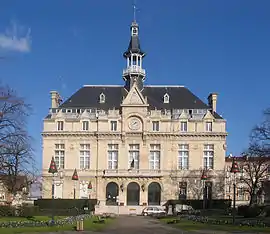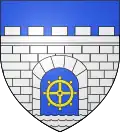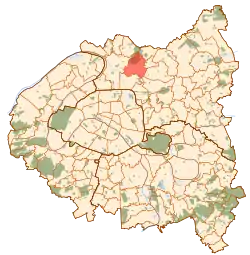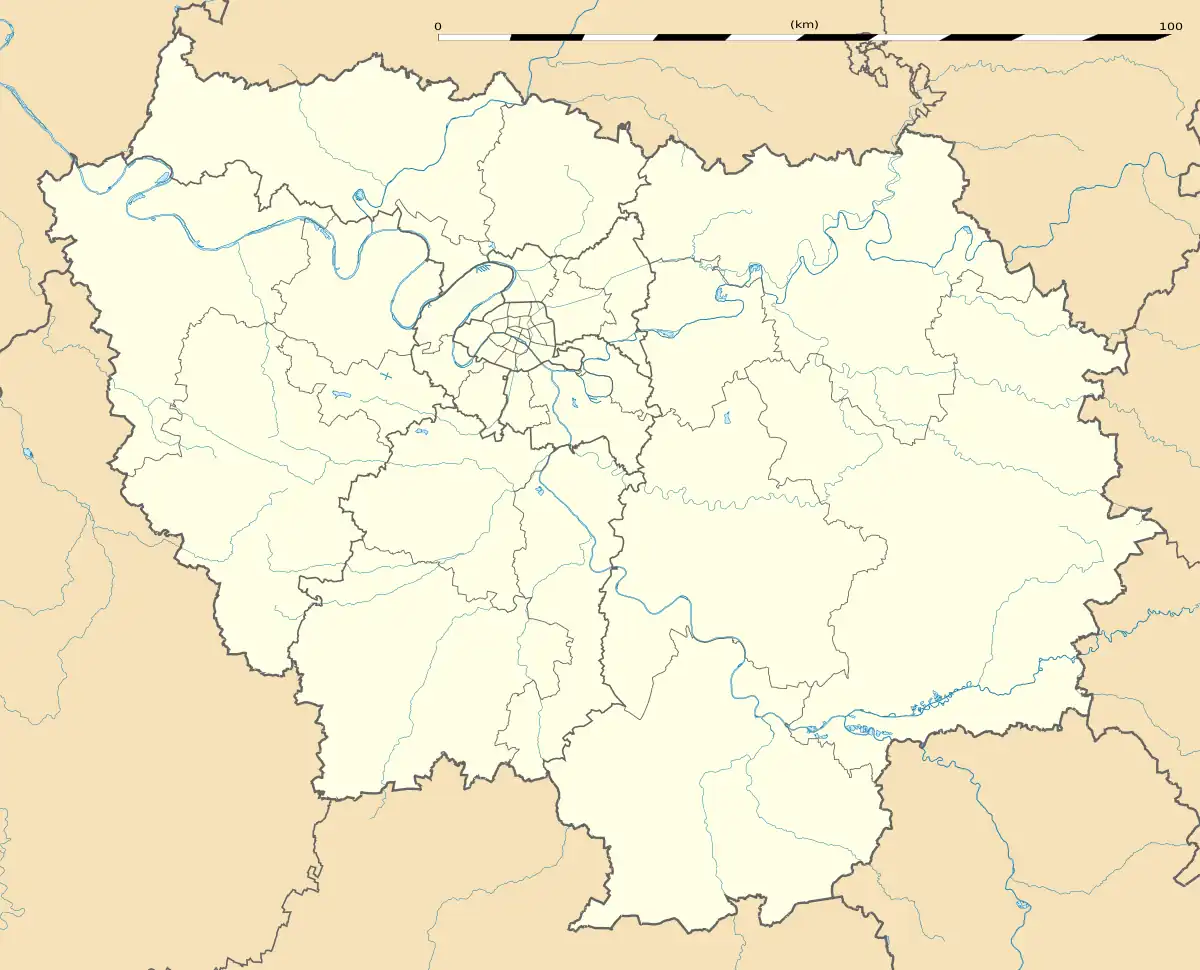La Courneuve | |
|---|---|
 Town hall | |
 Coat of arms | |
 Paris and inner ring départements | |
Location of La Courneuve | |
 La Courneuve  La Courneuve | |
| Coordinates: 48°55′56″N 2°23′48″E / 48.9322°N 2.3967°E | |
| Country | France |
| Region | Île-de-France |
| Department | Seine-Saint-Denis |
| Arrondissement | Saint-Denis |
| Canton | La Courneuve |
| Intercommunality | Grand Paris |
| Government | |
| • Mayor (2020–2026) | Gilles Poux[1] (PCF) |
| Area 1 | 7.52 km2 (2.90 sq mi) |
| Population | 47,160 |
| • Density | 6,300/km2 (16,000/sq mi) |
| Time zone | UTC+01:00 (CET) |
| • Summer (DST) | UTC+02:00 (CEST) |
| INSEE/Postal code | 93027 /93 120 |
| Elevation | 29–60 m (95–197 ft) (avg. 40 m or 130 ft) |
| 1 French Land Register data, which excludes lakes, ponds, glaciers > 1 km2 (0.386 sq mi or 247 acres) and river estuaries. | |
La Courneuve (French pronunciation: [la kuʁnœv] ⓘ) is a commune in Seine-Saint-Denis, France. It is located 8.3 km (5.2 mi) from the center of Paris.
History
Inhabited since pre-Roman times, the area is thought to have been a small village up through the Middle Ages. With its proximity to Paris, it soon became a fashionable country destination, with a number of gentry residing there. It had two notable châteaux - Sainte-Foi and Poitronville. Towards the end of Napoleon's reign, the entire area experienced large population growth. This along with improved methods of farming eventually transformed the area into the major legume producer for the Paris regional.
In 1863, the first major industrial enterprise was introduced and the area soon became a strange mix of factories and farmlands. Industrial estates were juxtaposed with bean plantations and that would continue until after World War II.
During the 1960s, as Paris could no longer meet the demands of a further exploding population (largely the result of immigration from former colonies), La Courneuve, like many other suburbs of Paris, was designated as one of the "zones à urbaniser en priorité" (areas to be urbanized quickly) and was built up at a very rapid pace, with the construction of large council estates and tower blocks and other HLM developments. Between 1962 and 1968 the population nearly doubled.
Heraldry
 arms of La Courneuve |
The arms of La Courneuve are blazoned : Azure, a wall embattled argent masoned sable, open to the field contain a millwheel Or above waves argent | |
| motto: droiture et tendresse ("righteousness and tenderness") | ||
Demographics
|
| ||||||||||||||||||||||||||||||||||||||||||||||||||||||||||||||||||||||||||||||||||||||||||||||||||||||||||||||||||
| Source: EHESS[3] and INSEE (1968-2017)[4] | |||||||||||||||||||||||||||||||||||||||||||||||||||||||||||||||||||||||||||||||||||||||||||||||||||||||||||||||||||
Immigration
| Born in metropolitan France | Born outside metropolitan France | |||
|---|---|---|---|---|
| 62.6% | 37.4% | |||
| Born in overseas France |
Born in foreign countries with French citizenship at birth1 | EU-15 immigrants2 | Non-EU-15 immigrants | |
| 3.1% | 3.5% | 4.1% | 26.7% | |
| 1 This group is made up largely of former French settlers, such as Pieds-Noirs in Northwest Africa, followed by former colonial citizens who had French citizenship at birth (such as was often the case for the native elite in French colonies), as well as to a lesser extent foreign-born children of French expatriates. A foreign country is understood as a country not part of France in 1999, so a person born for example in 1950 in Algeria, when Algeria was an integral part of France, is nonetheless listed as a person born in a foreign country in French statistics. 2 An immigrant is a person born in a foreign country not having French citizenship at birth. An immigrant may have acquired French citizenship since moving to France, but is still considered an immigrant in French statistics. On the other hand, persons born in France with foreign citizenship (the children of immigrants) are not listed as immigrants. | ||||
Education
Preschools and primary schools[5]
- Anatole-France
- Charlie-Chaplin
- Irène-Joliot-Curie
- Louise-Michel
- Paul-Doumer
- Paul-Langevin / Henri-Wallon
- Robespierre / Jules-Vallès
- Saint-Exupéry
- Raymond-Poincaré
- Rosenberg
- Joséphine-Baker
- Angela Davis
High schools/junior high schools:[6]
- Collège Raymond-Poincaré
- Collège Jean-Vilar
- Collège Georges-Politzer
Sixth-form colleges/senior high schools:[6]
- Lycée Jacques-Brel
- Lycée d'enseignement professionnel Denis-Papin
- Lycée Arthur-Rimbaud
Transport
La Courneuve is served by La Courneuve – 8 Mai 1945 station on Paris Métro Line 7 and by La Courneuve – Aubervilliers station on Paris RER line B.
Notable people
- Haris Belkebla, Algerian footballer
- Suzanne Masson, French resistance fighter, (1901-1943)
- Dinos (rapper), French Rapper
See also
- Communes of the Seine-Saint-Denis department
- Stade de Marville
- Centre des archives diplomatiques de La Courneuve
References
- ↑ "Répertoire national des élus: les maires" (in French). data.gouv.fr, Plateforme ouverte des données publiques françaises. 6 June 2023.
- ↑ "Populations légales 2021". The National Institute of Statistics and Economic Studies. 28 December 2023.
- ↑ Des villages de Cassini aux communes d'aujourd'hui: Commune data sheet La Courneuve, EHESS (in French).
- ↑ Population en historique depuis 1968, INSEE
- ↑ "Écoles maternelle et élémentaire." La Courneuve. Retrieved on August 19, 2016.
- 1 2 "Les collèges et lycées." La Courneuve. Retrieved on August 19, 2016.
- (in French) Un peu d'histoire. 07 Feb. 2006. La Ville de La Courneuve
- Mayol, Pierre. "The Policy of the City and Cultural Action". Canadian Journal of Communication Vol. 27, No. 2 (2002)
- (in French)Van Renterghem, Marion. "La Courneuve, « Rebeus » et « Renois » disent la vie des « 4000 »." Le Monde, 1 July 2005
External links
- Official website
- (in French)